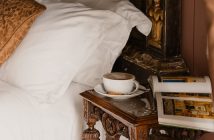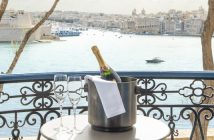‘I wonder if Mick Jagger ever picked one of those oranges,” I pondered, spying the golden treasures in a nearby tree, as I lay back, floating in the luxury of the Hotel Byblos pool.
My gaze turned to the diving swallows, the gentle clatter of al fresco tables being laid up around the pool’s perimeter for breakfast, and the morning sun as it crept slowly across the jagged outline of the five-star hotel’s façade, dialling up the chalky tones to their vibrant max. It was a perfectly still, early summer morning in Saint Tropez, and my head, muggy from a late evening of convivial dining and drinks, was starting to clear. Such is the magic of a solitary 7am swim, in an outdoor pool, when almost everyone is still tucked away in bed, and you’re free to loll around at will. The ultimate cure for the jet-lagged or over-imbibed… I digress. Back to the moment. The oranges. Mick Jagger.
This isn’t some Rolling Stone fantasy I’m sharing with you here. Mick and his moves don’t usually enter my thoughts. The rock ‘n’ roll star and his beloved of the time, Bianca, held their wedding party in this very spot, attended by a who’s who from Keith Richards and Paul McCartney, to an actual Who, Keith Moon. If the hotel’s founder, Lebanese billionaire, Jean-Prosper Gay-Para, had had it his way, it would have been him and Bridget Bardot stepping over the threshold as husband and wife.

Hotel Byblos was built in a bid to woo the actress, whom he was besotted with since she appeared in, And God Created Women; a film which elevated her to international fame and shone an equally enticing light on Saint Tropez, attracting he and the A-listers to holiday there in droves. Bardot, among many other notable names of the time, attended the three-day launch party in 1967 still talked about today, though sadly Gay-Para’s bid for her love was less successful. She married another man, Gay-Para was pulled back to Lebanon for the Six-Day War, where he stayed, and the hotel was sold to Sylvain Floirat, where it remains in the family today.
Hotel Byblos turned 50 in 2017, and except for a little nip and tuck, an expansion in the 80s taking it from 52 to 91 rooms, and a renovation of the suites to mark its anniversary, it remains relatively unchanged. The style is part Lebanese citadel, part Provencal village, with the sloping red-tiled roofs, ochre, peach and terracotta-painted walls, colourful wooden shutters, and wrought-iron balconies that epitomise the latter, mingling with ceramic frescos by Roger Capron, trompe l’oeil murals, and ancient Lebanese artefacts. The most striking export from Gay-Para’s homeland is the intricately carved and painted wood he rescued from a 16th century Beirut palace, which decks the walls and ceiling of the Lebanese Salon, a luxurious private suite in the onsite Byblos Spa by Sisley for pampering a deux. It is breathtaking in its beauty.

Gay-Para named the hotel after the Lebanese port town of Byblos, which not only bared a resemblance to the then sleepy Saint Tropez, but in Greek mythology, was where Adonis and Aphrodite became lovers. It’s affectionately referred to as, the ‘village within a village’, and for good reason. Each section of the building is a different height, width and colour, so it looks like a series of houses, rather than one hotel. Nestled into the complex across multiple levels is two restaurants, a nightclub, a spa, fitness centre, a little gallery, wine shop, the newly-added L’Epicerie by Byblos, and 91 bedrooms and suites.
The abodes are generous in size and unique in layout and décor. The grandest is the Missoni suite with triple windows looking out to the pool, a private terrace, and a rainbow of colour and pattern inside. My duplex room, tucked away at the other end of the hotel, down a corridor decorated with ceramic murals and vintage furniture, was doused in earthy tones, with stairs leading up to a mezzanine housing a king size bed and bathroom. Others have balconies looking out to the town and across to the Maures mountains, or roomy enclosed terraces. Throughout the grounds, heady jasmine, purple bougainvillea, cacti, olive trees and the aforementioned orange add to the palatial feel Gay-Para was striving for, and matches the Palace status Byblos was awarded in 2012 by the French Ministry of Tourism, as a mark of its excellence.

Staying true to its roots, Byblos loves to throw big parties (such as the annual summer soiree attracting around 2,000 revellers), and attracts nightly queues its downstairs nightclub, Les Caves du Roy, but rowdy it is not, and the day to day vibe is very laid-back. Breakfast is unhurried and the buffet spread bounteous; made for lingering over for as long as the day’s schedule allows. Expect freshly-baked madeleines to pluck from the tray, a typically-French cheese display of feastial proportions, homemade granolas with myriad angelic toppings: spirulina, turmeric, goji berries… Little bricks of beurre Bordier, you’ll want to spread thickly on to the just-baked breads and eat with your eyes closed. Fresh fruit nectars and coconut water, and Mariage Frere tea to order. Children will enjoy the fun little treats laid out for them, and the gluten-free can rest easy, there’s plenty to satiate them too.
Lunch follows casually at poolside restaurant, Le B, where the chef’s selection of specials is dictated by the market, fish of the day is presented whole, and then delicately removed from the bone, and ordering from the Salad Bar card of 50 ingredients is equal parts fun and agonising (you’ll see what I mean). By night, Le B turns into a cosy candlelit corner, serving a grand selection of cocktails and mezze, accompanied by a house band so good, they should be famous. Downstairs at street level, there’s the occasion-worthy, Rivea by Alain Ducasse.

Book a table on the terrace, to fully enjoy its magical setting, filled with lightbulb-strung trees, and cushion-dotted wicker seats filled with families and couples. Executive chef Vincent Maillard and his team have a slick operation in place, delivering dishes that make the most of the fabulous local produce and seasons. When I visited, that included wild fennel stuffed bass with Haut-Var saffron, indigenous jumbo blue prawns served with rock octopus, coco beans and rosemary, and white asparagus with crushed sorrel. All very delicious.
There followed the signature Alain Ducasse cookpot of chocolate and toasted buckwheat, which was up there with the best, and Rivea’s take on the traditional tarte Tropezienne, a three-tired, light as air, citrus sponge, sandwiched with cream and nuts. If I get married, I’ll chose that as my cake. Dinner ended on a high with some homemade limoncello, before returning to Le B for a postprandial tipple, and then sloping down to Les Caves du Roy, to dance among the palm tree pillars, chromatic strobes, and poufs from the smoke machine until into the early hours, just like Grace Jones, Jack Nicholson and Cher had done many, many moons before. That 7am swim I was telling you about, followed shortly after.

It’s easy to forget there’s a world outside the bubble of Byblos. When you’re ready to venture forth, Saint Tropez town awaits, out the rear entrance and about three minutes’ walk down the hill. It’s a pretty little place, made for strolling through at vacation pace. In the afternoons, the local gents gather to play petanque on the Place des Lices, a location transformed into a hive of stalls and weaving crowds come the Tuesday and Saturday morning market, where you can spread your Euros far on excellent and varied array of local goods, from grappes of purple garlic to pom-pom adorned weaved baskets; pretty cotton dresses to antiques.
The narrow lanes leading off hide big name designer stores, art galleries, and independent boutiques, to tease you as you walk towards the sea. Et voila! You’ve arrived at the port. Atop the crystal clear Cote d’Azur water, bob dream boats and private yachts, a merry dance to those wining and dining at the collection of cafes, ice cream shops and restaurants lined up in front. A walk to the top of the harbour wall reveal postcard views of the town one way, and across the sea to Sainte Maxime, the other.

If you exit Hotel Byblos from the front entrance, up and passed the citadel, and along a wildflower path for about five minutes, you’ll be rewarded with even better Saint Tropez vistas, possibly the best-located graveyard, and an iridescent sea of every blue.
Open from April to October, Hotel Byblos is an enticing little hideaway, where one would feel just as comfortable travelling to alone, with a thick book and bottomless glass of Bertaud Belieu rosé, as with a multi-generational family in tow. Or with a close knit of girlfriends to dip into the Sisley spa, for glow-giving treatments in candle-lit rooms. You’ll eat, drink and sleep well, and want for nothing. Except to stay a little longer. How on earth Jean-Prosper Gay-Para failed to hook Bardot with this one, is beyond me.
Hotel Byblos, 20 Avenue Paul Signac, 83990, Saint-Tropez – France. Tel: +33 (0) 494 56 68 00 For more information, visit www.byblos.com.
Photography © Alexandre Chaplier.




